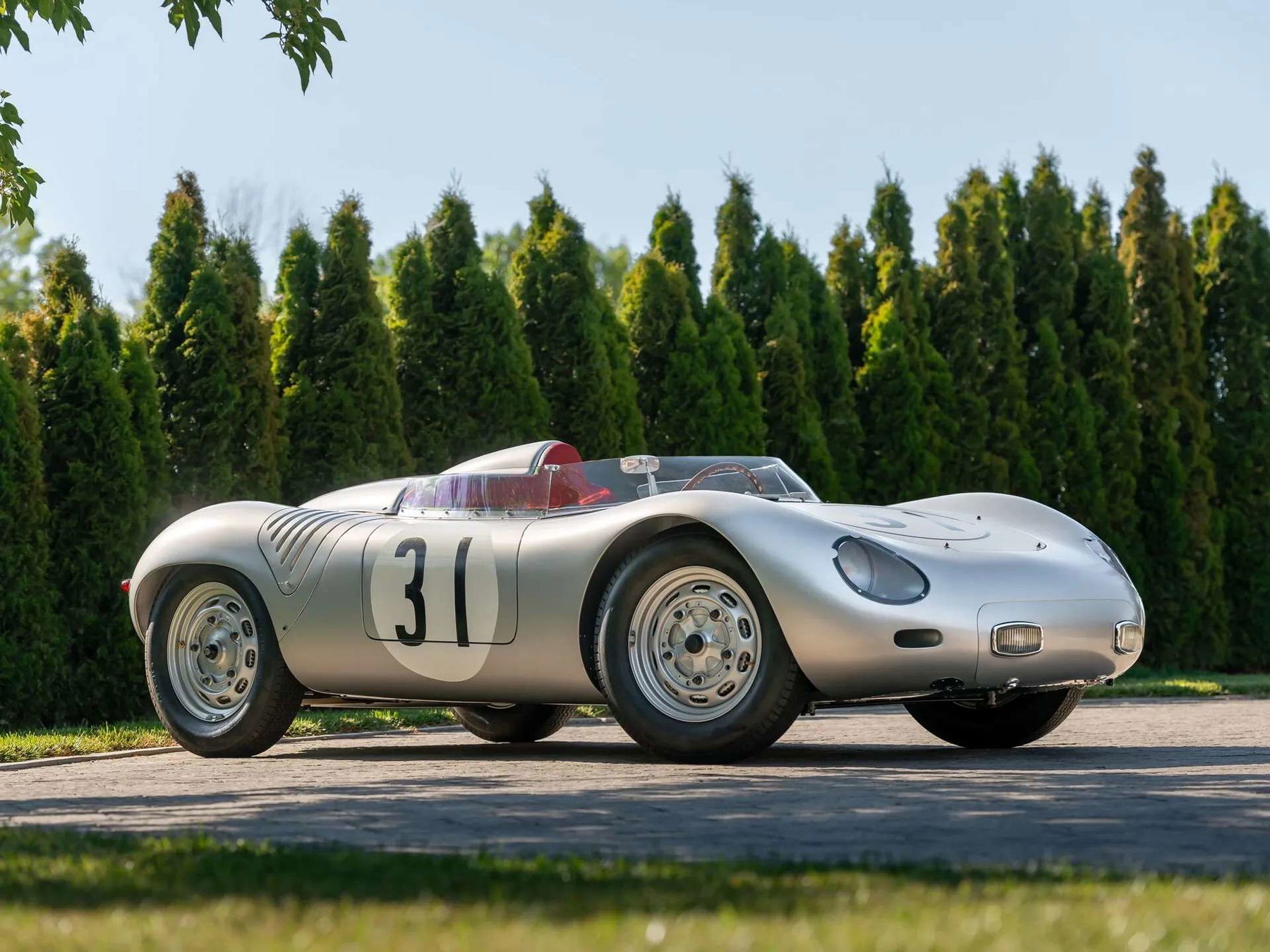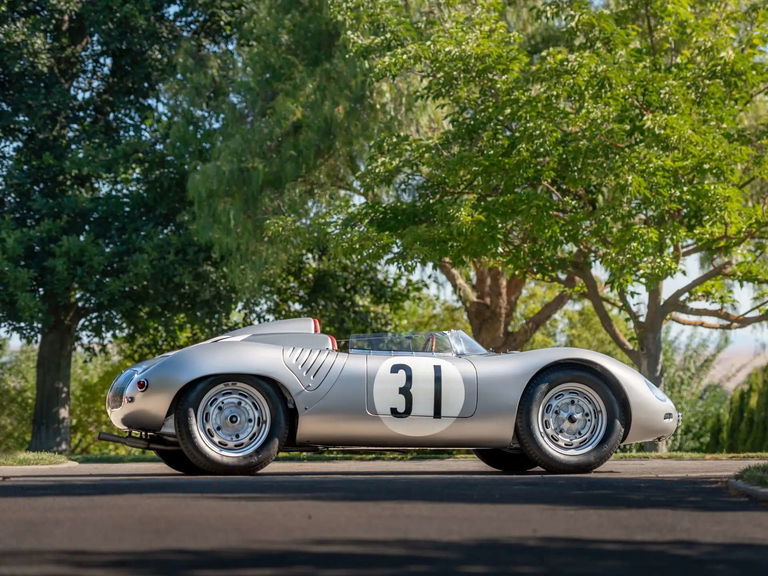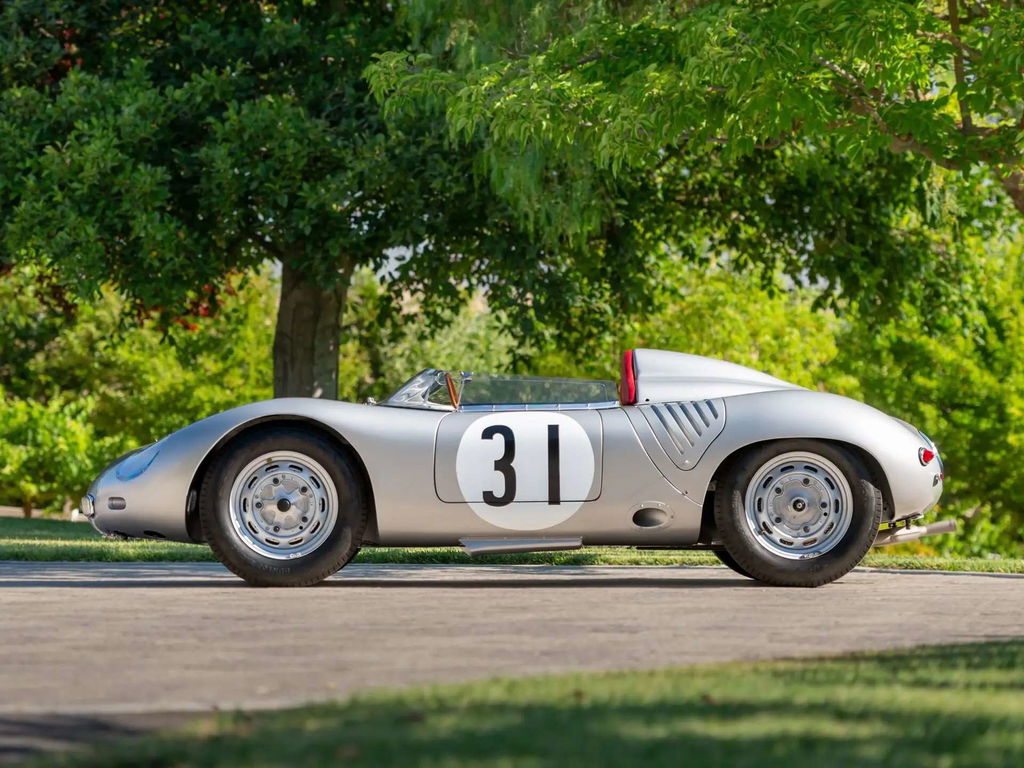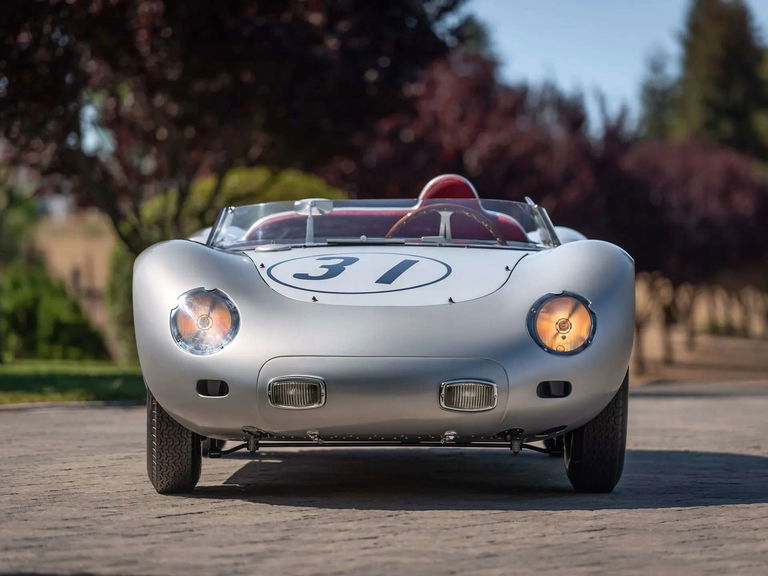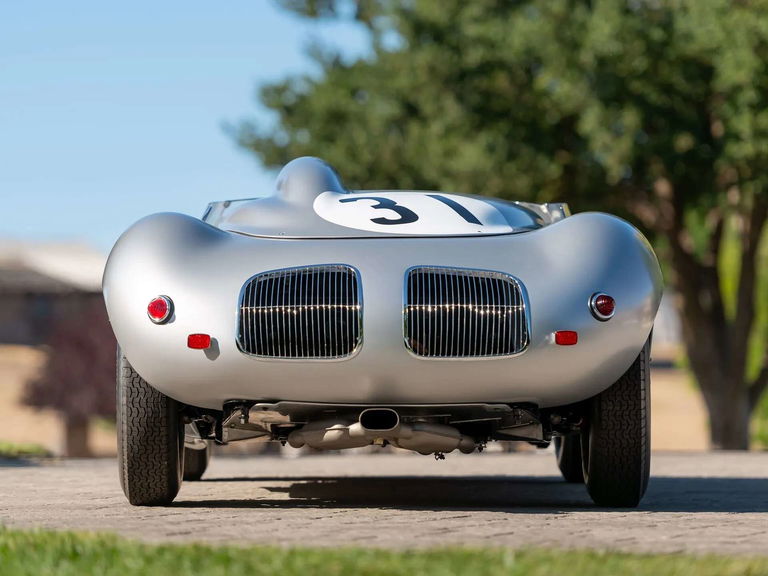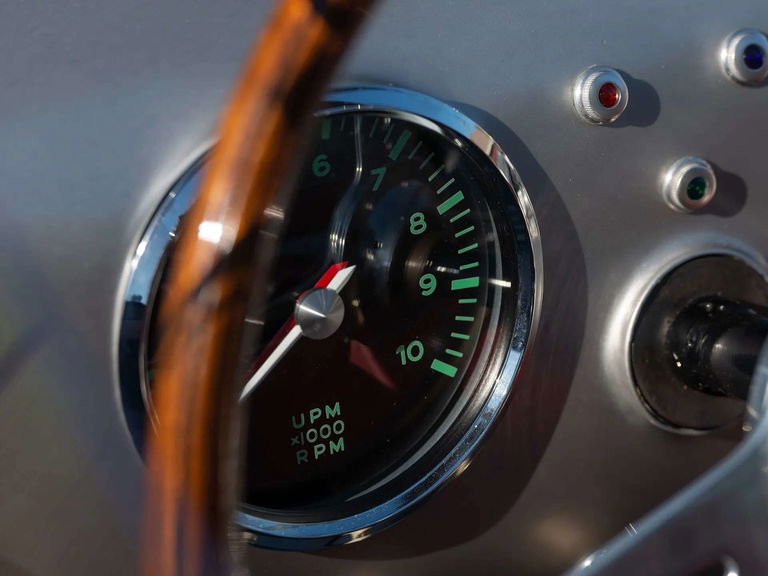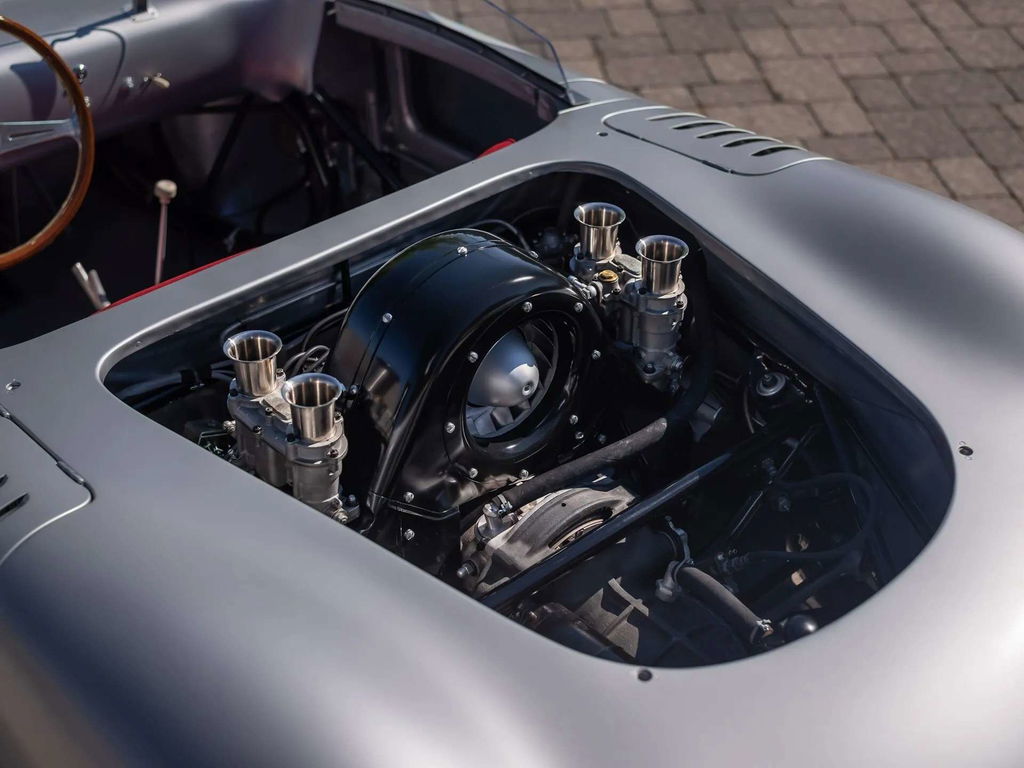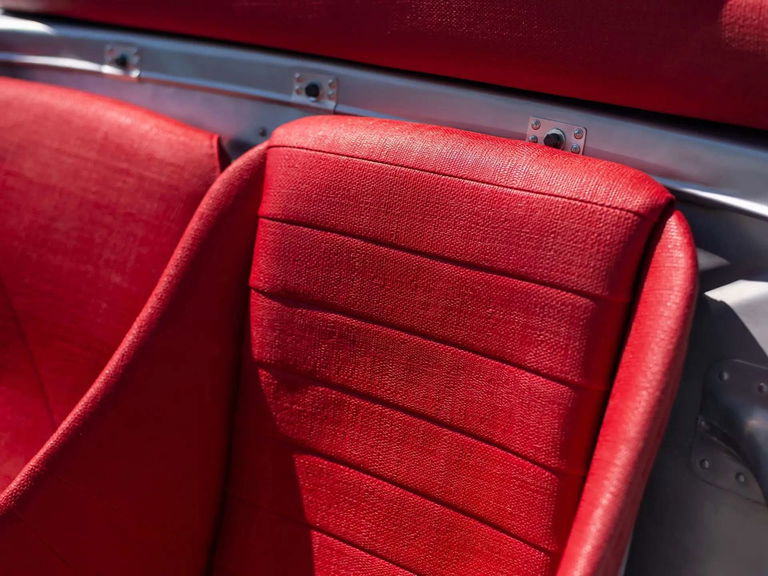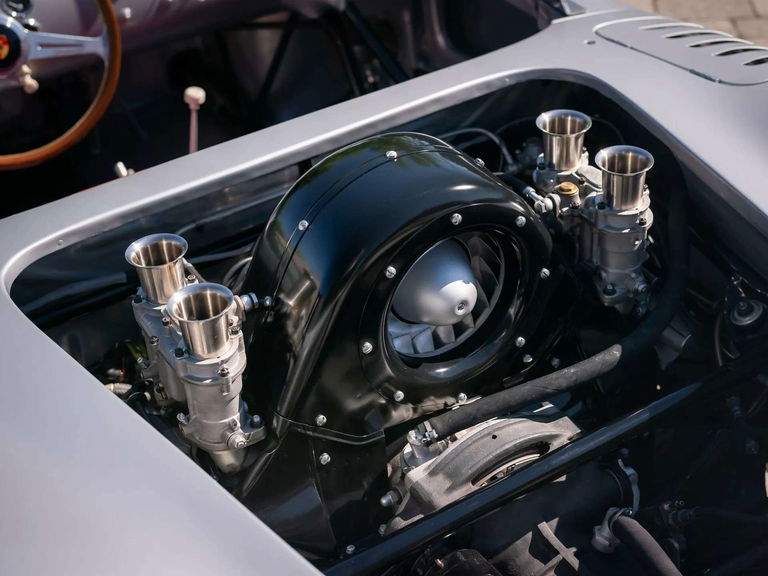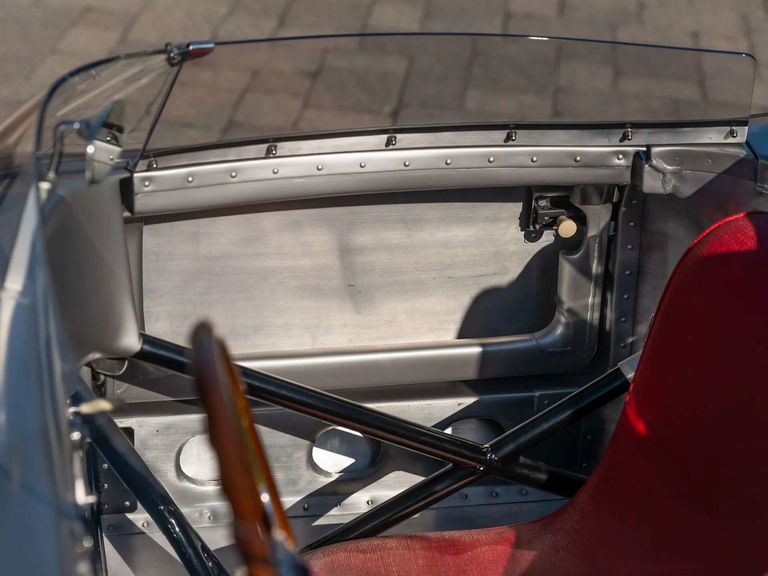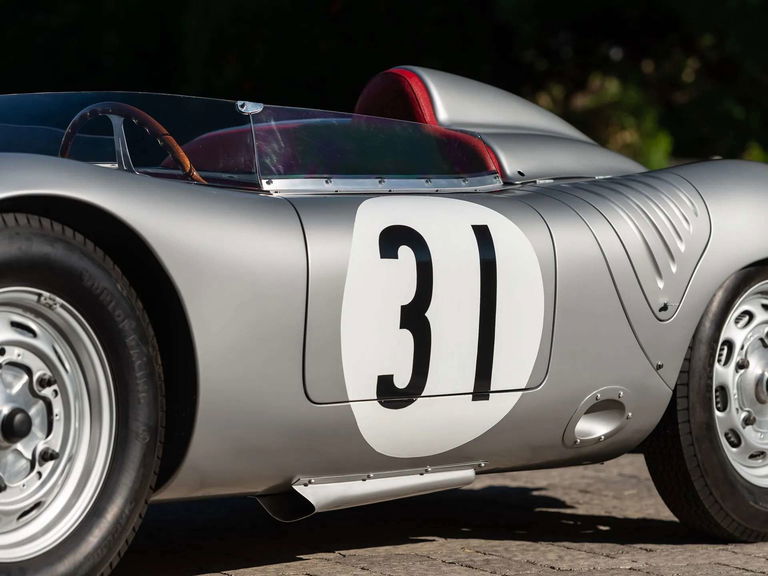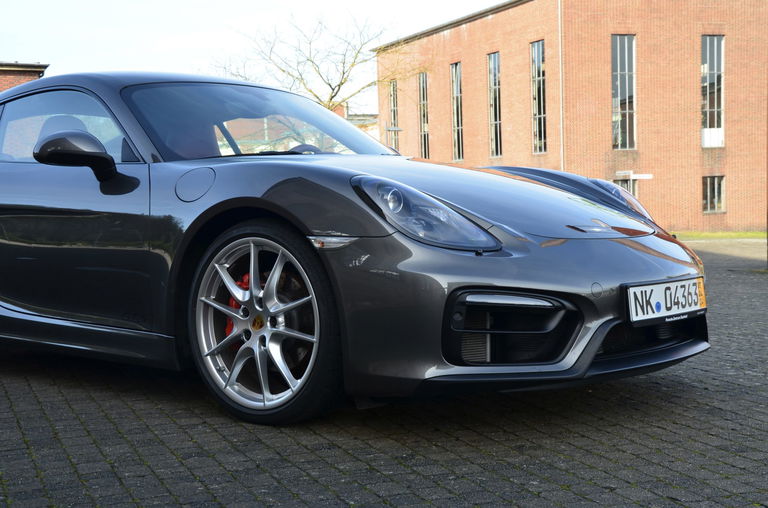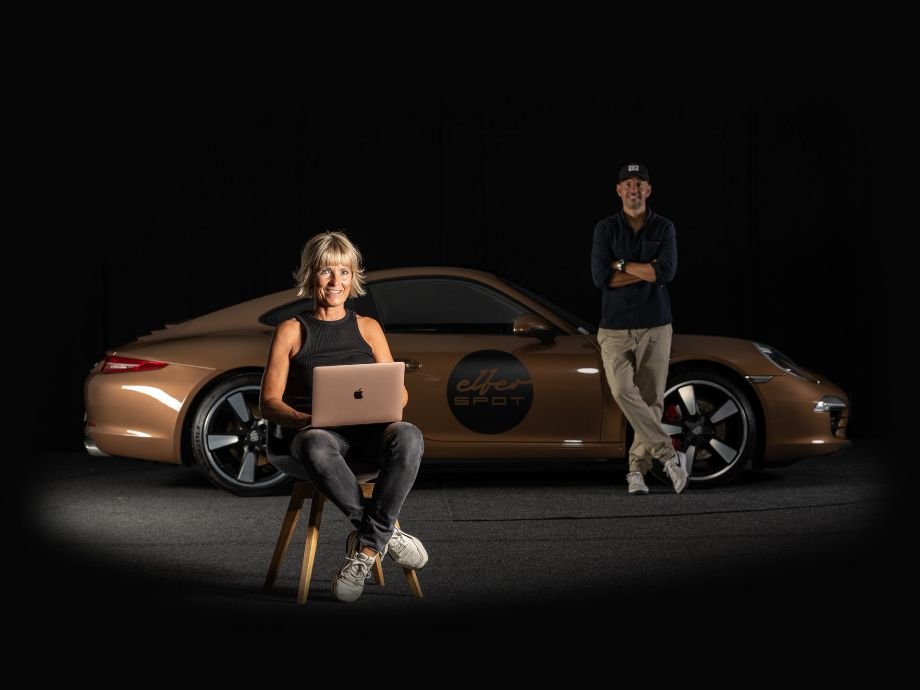All 718s were powered by the potent Type 547 “Fuhrmann” four-cam engine, with displacements of both 1.5 and 1.6 liters, allowing Porsche to choose the racing category it wished to enter. With large Weber twin-choke carburetors, these engines produced between 150 and 170 horsepower, and proved extremely reliable. Power was fed through a five-speed ZF gearbox with limited slip, and gave top speeds approaching 160 mph. Brakes were large finned drums, and the 16 x 3.5-inch bolt-on wheels comprised steel centers riveted to aluminum outer rims. The alloy bodywork was a bit longer and much more streamlined than the 550’s, with a taller windscreen to meet the FIA’s Appendix C rules.
Among the items tested on some 718 Werks prototypes was an auxiliary tubular oil radiator attached to the underside of the front hood. This was another development that was used in chassis 718-006, and it has been authentically represented on this chassis’ restoration, complete with the cadmium-style finish both on the top of the hood and the grooves and fittings beneath.
718-006 LIGHTS UP THE COMPETITION
The Porsche 718 RSK broke onto the racing scene victoriously, proving itself at the 1958 24 Hours of Le Mans and earning a huge 1st in class win (and 3rd overall) at the hands of Jean Behra and Hans Herrmann. The model was instantly recognized as a force to be reckoned with on the big stage, but clearly needed improvement to take on the motorsport world’s toughest challenges. In particular, Sebring and the Nürburgring—two of the most notoriously brutal tracks that FIA had to offer, each punishing in its own distinctive way—would prove the ultimate test for the 718.
Sebring, a converted WWII airfield and bomber training base, was known to be especially harsh. Rough and unpredictable, it offered sketchy terrain and constant weather changes, with veteran racers noting that you might well “start in the dry” and “finish in the wet;” attrition rates for Sebring race entrants often exceeded 50%. Formula One champion Phil Hill, commenting to Sports Illustrated on Sebring several years prior, said that “It’s monstrous. I’ve never seen anything like it before, at Le Mans or anywhere else.” The Nürburgring offered an equal challenge; one of the world’s deadliest courses, the lives of many sportsmen were tragically taken by the “Ring’s” fast declines and deceiving corners with quick elevation changes.
Porsche’s answer to these challenges was this car, Werks prototype chassis 718-006. Its double-wishbone suspension and rear coil-overs were the perfect complement to the Spyder’s sprightly 82-inch wheelbase chassis and light weight (just 1,240 pounds). These developmental upgrades improved high-speed handling and stability, allowing the car to tackle both rough terrain and dynamic road courses with confidence and composure—turning a promising racer into and all-around weapon that became nothing short of unstoppable.
Chassis 718-006 first raced for the Porsche factory team at the 1959 12 Hours of Sebring. The weather was, true to Sebring form, unpredictable, with the race starting under an overcast fog, turning into heavy rain at the halfway point and flooding portions of the track. Despite these difficult conditions, chassis 718-006 managed to finish 1st in class and 3rd overall, with drivers Wolfgang von Trips and Jo Bonnier at the wheel. This was an incredible achievement for Porsche, and the new 718 RSK proved its might against much larger-displacement competitors. While Ferraris of nearly twice the displacement took the top two places, Porsche 718s achieved a remarkable 3rd, 4th, 5th, 8th, and 10th overall. Porsche would celebrate the event by issuing a famous poster for display at its dealerships around the world.
After its 1st in class finish at Sebring, chassis 718-006 was sent back to Zuffenhausen, where it was refurbished and prepared for the Targa Florio. Legendary drivers Umberto Maglioli and Hans Herrmann raced 718-006 at the Sicilian event, but unfortunately, the car was forced to retire due to gearbox failure. Porsche’s Targa Florio endeavor was not in vain, however, as another Werks 718 would go on to not only win its class but the overall honors as well.
Chassis 718-006 once again found its groove at the ADAC Nürburgring 1000 KM. Co-driven again by Herrmann and Maglioli, the Werks car battled the Green Hell, and a stiff field of competitors, to win a triumphant 1st in class and 4th overall—a victory that, along with Sebring, proved the wisdom and capability of this chassis’ special double-wishbone suspension setup, leading to the basic design’s use in competition cars by both Porsche and its rivals up to the present day.
Just two weeks after its class win at the Nürburgring 1000 KM, 718-006 was raced at the 1959 24 Hours of Le Mans with Edgar Barth and Wolfgang Seidel at the wheel. One-hundred and sixty-eight laps into the grueling race, 718-006 was sidelined due to a failed clutch. Just 13 of the 53 entries in Le Mans that year finished the race, and none of the Porsches Werks entries were successful. Barth raced the car after quick repairs a week later at the Mont-Ventoux Hillclimb where he took the best time; that year, he also won the season’s European Hillclimb Championship for Porsche.
A month later, Jo Bonnier would take 718-006 to a 2nd-place finish in the 1500 cc supporting race at the Berlin Grand Prix. A week later, he raced 718-006 again, placing 4th at Sweden’s Karlskoga Motorstadion. The season concluded with Porsche achieving a perfect 1–5 finish at Switzerland’s Klosters-Davos Hillclimb, with all five spots being made up of 718s.
1960 brought both new FIA rules and a new, improved sports racer from Porsche, the RS60. No longer competitive in Europe, Porsche sent 718-006 to the Nassau Speed Weeks in December 1959 hoping to find an American buyer via a broker, Lloyd Casner. Casner put Jack MacAfee into 718-006, and the car finished 4th in a five-lap all-Porsche race and 3rd in the Nassau Trophy race.
Ultimately, chassis 718-006 had podium finishes in more than half of all events entered throughout its Werks career, including two 1st in class finishes at prestigious international endurance races.
THE PRIVATEER YEARS AND BEYOND
The Spyder was then purchased by Chuck Cassel, a Florida Porsche dealer and racer. During 1960, Cassel raced the car extensively in Florida and Georgia, and once in El Salvador before selling it to Felipe Gutierrez, a wealthy Cuban who raced it twice in 1961. Then the Spyder retired from racing competitively for the next 15 years.
It re-surfaced in 1975 at Ben Pon Racing in Holland, from which it was acquired by German orthodontist Dr. Klaus-Otto Räker. Unfortunately, its original engine was reportedly damaged beyond repair in a competition outing; Dr. Räker turned to well-known four-cam supplier Jim Wellington for a new 547/2 case, which was built up by renowned expert Karl Hloch, Sr. using an 80-millimeter crankshaft and 1.6-liter pistons. Dr. Räker commissioned a five-year restoration by Edmund Klinke at Oldtimerrestauration in Verl, Germany; using the original panels and factory blueprints, Klinke fabricated new outer body panels to replace the undamaged, but fatigued, original skin which at the time was determined to be beyond saving.
Rather than having the new body painted, Dr. Räker instructed that the skin be meticulously polished to a mirror finish. A centerpiece of his museum, when the gleaming 718 appeared at the 1985 Old-Timers Grand Prix at the Nürburgring, it was instantly dubbed “The Shining Spyder.” Among the spectators was a young American designer named Grant Larson, who was beginning a brilliant career at Porsche. When Larson was tasked to design the exterior of the new Boxster, the highly polished RSK epitomized what he viewed as the “total it car”, the most “influential and inspirational” Porsche design.
Elements of the 718 would appear on the Boxster show car, and in 1992, Larson created a painting of “The Shining Spyder” as part of a series of factory art posters. Over the years, Dr. Räker continued to drive his RSK in European vintage events, and in 1998 it appeared at the Monterey Historics.
A WELL-DESERVED, WORLD-CLASS RESTORATION
In 2012, an American four-cam collector requested Colorado restoration shop owner Dick Koenig to find a good 718 RSK. That year, Koenig met Dr. Räker at Gaisberg; two years later a sale was consummated. The RSK was shipped to Koenig’s shop near Denver where another full restoration began, consuming four years. The goal was to bring 718-006 back to its original condition to the greatest possible extent. In pursuit of this, Koenig travelled to California, Florida, and the Netherlands to study details of other prototype 718s.
It was ultimately determined that much of the car’s inner body panels needed replacement. The work was carried out by The Metal Surgeon’s Jon Bingham, after which the body shell was refinished and painted by Dave DeMaria at Vintage Car Works, both located in Englewood, Colorado. DeMaria took great pains to authentically replicate the finishes as they looked in period, from the dull silver bodywork to the unique appearance of the hood—which was originally cadmium-plated in an attempt at dispersing the heat from the aforementioned experimental oil radiator system.
The drivetrain had already been serviced by German four-cam expert Karl Hloch, Jr., but Koenig and Pat Moyle overhauled the brakes, suspension, and steering and installed a new wiring harness. New fuel and oil tanks were fabricated using a hard-to-find original material called “Terneplate.” These tanks are secured with metal straps and factory-correct jute insulating material. Though this material is said to be nearly impossible to find, Koenig located a small supply in Europe, just enough to give 718-006 its proper factory-correct appearance.
The original upholstery consisted of a textured material called Acela Bast; Koenig found an un-faded scrap beneath the auxiliary gas tank in the cockpit of a highly original Porsche 550A used as a reference car, managing to locate enough to cover the seats and headrest. The experimental front lid with its integral oil radiator has been perfectly restored, but the tubes have been disconnected; the normal radiators in the rocker panels suffice to keep the little four-cam within an acceptable temperature range. Further, a set of correctly dated 16-inch wheels were sourced.
Since its restoration, this 718 RSK has appeared at Amelia Island and Rennsport VI, and in November 2020 was featured in Excellence magazine. It has been displayed in the current owner’s collection since restoration, where he maintains his extensive collection of high-performance sports and racing cars. In preparation for the sale, RM Sotheby’s enlisted aluminum Porsche expert Urs Gretener of Paso Robles, California to fully inspect 718-006. Gretener closely inspected the tube chassis and found that other than a few repairs (documented in the restoration book on file) the chassis appeared to be original, with all tubes being the proper diameter for this chassis and period gas welding throughout.
Among the most successful examples of its kind, chassis 718-006 is now presented having benefitted from its recent multi-year restoration. It is accompanied by a mirror-polished alloy hood panel autographed by Hans Herrmann, the car’s original dashboard, and other inner body panels replaced by Dick Koenig during its restoration.
A benchmark in Porsche racing history, 718 RSK Werks Spyders are very rarely offered for sale. This Werks car, 718-006, boasts an incredible racing record in the hands of some of the era’s great drivers. It is unquestionably ready to become the crown jewel of any prestigious collection of historic racing cars.
|
| COMPETITION RECORD OF PORSCHE RSK 718-006 |
|
| WORKS RESULTS |
|
| RACE |
DATE |
DRIVER |
RESULT |
| 12 Hours of Sebring |
21 March 1959 |
Bonnier/von Trips |
1st in class, 3rd OA |
| Targa Florio |
24 May 1959 |
Herrmann/Maglioli |
DNF (transmission) |
| Nürburgring ADAC 1000 KM |
7 June 1959 |
Herrmann/Maglioli |
1st in class, 4th OA |
| 24 Hours of Le Mans |
20-21 June 1959 |
Barth/Seidel |
DNF |
| Mont Ventoux Hillclimb |
28 June 1959 |
Barth |
1st OA |
| Berlin GP AVUS supporting race |
1 August 1959 |
Bonnier |
2nd place |
| Karlskoga Autodrome |
8 August 1959 |
Bonnier |
4th place |
| Klosters-Davos Hillclimb |
30 August 1959 |
Herrmann |
1st OA |
| Nassau Porsche-only |
12 December 1959 |
MacAfee |
4th in class (5 laps) |
| Nassau Trophy |
12 December 1959 |
MacAfee |
17th OA, 3rd in Class E (49 laps) |
|
| PRIVATEER RESULTS |
|
| Dunellon Park, Florida |
16 January 1960 |
Cassel |
2nd in class |
| Dunellon Park, Florida |
17 January 1960 |
Cassel |
1st |
| Daytona Speed Week |
30 January 1960 |
Cassel |
DNF |
| Daytona Speed Week |
31 January 1960 |
Cassel |
4th OA, 1st in class |
| Pensacola Fiesta of 5 Flags |
3 April 1960 |
Cassel |
5th OA, 3rd in class |
| VIR SCCA National |
1 May 1960 |
Cassel |
3rd OA, 2nd in class |
| Santa Ana, El Salvador |
22 May 1960 |
Cassel |
2nd OA |
| Cocoa-Titusville, Florida |
28 May 1960 |
Cassel |
DNF |
| Daytona Regional Qualifier |
25 June 1960 |
Cassel |
DNF (crankshaft) |
